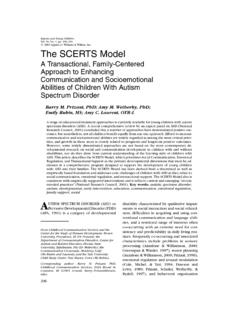Transcription of Malnutrition: long- term consequences and …
1 ESTUDOSAVAN ADOS20 (58), 2006147 malnutrition : long -term consequences and nutritional recovery effectsANALYDIASAWAYAH ealth, nutrition and life conditionsNOWADAYS, it s ever clearer that, for a real understanding of the diseases and their consequences , the anthropological aspects, the psychological dynamism and the social diagnosis of the physically frail people must be considered. For example, the physiological evidences that it s necessary to see man as an integrated phenomenon instead of as independent parts among itself, have increased. A reasonable amount of scientific papers offers ever more examples of that integrality, such as the studies on the effects of happiness on the person s health by the end of his or her life. A study carried out in the United States, for example, concluded that, within a sample of catholic nuns, writings with a positive emotional content at 22 years old were associated with health and longevity at 60 years old (Danner et al.)
2 , 2001). Therefore, as far as physiology is concerned, what goes on with a person who considers him or herself happy? There are strong relationships between that kind of statement, life expectancy and the frequency and intensity of chronic diseases, such as cardiovascular, inflammatory and self-immune ones (Steptoe et al., 2005). Such studies identified an inversely correlate biological marker to that happiness declaration: cortisol, the stress hormone. The higher its levels in the saliva when the person wakes up, the greater the stress level and the worse is the life quality in the long -term. It has become increasingly difficult to separate the human being into The life quality of the human being depends on what he feels and on the meaning he gives to things, and both are associated to his physiological status. Those same mechanisms are activated when the person receives insufficient feeding in quantitative terms , or inadequate feeding in qualitative terms (when there s a lack of necessary nutrients, such as vitamins and minerals), mainly early in life.
3 The organ that controls all our metabolic activity, the nervous system, permanently programs itself to save energy in the form of fat and to reduce growth, in order to guarantee survival in adverse ESTUDOSAVAN ADOS20 (58), 2006148conditions. One of the essential hormones for that is cortisol. That situation is called malnutrition , and the hormone that regulates it, along with others, is, for that reason, the stress hormone. The vicious circle made up of inadequate food intake/ diseases increase is also well-known: weight loss, deficient growth, low immunity, damage to the gastrointestinal mucous membrane, appetite loss, bad food absorption, important metabolic alterations. And we always come back to the stress hormone high cortisol , which will later play a very important role in the association of malnutrition with chronic diseases in the adult 1 Inadequate food intake/diseases increase vicious is responsible for 55% of children s deaths worldwide.
4 It s associated with many other diseases and still today it s considered the most deadly disease for children under 5 years and also in Brazil, the prevailing type of malnutrition corresponds to stunting, which has been standing out as an indicator not only of malnutrition , but also of poverty, since it s currently known that the environmental factor is much more significant than the genetic one to determine the individual s final height. There are several causes for stunting: insufficient nutrition of the mother, intra-uterine malnutrition , lack of breastfeeding until the child is six months old, late introduction of complementary foods, inadequate quantity and quality of complementary foods, nutrient absorption impaired by infections and intestinal parasitic 1 shows the importance of height as an efficient and direct poverty marker.
5 Here we have the average height of three adult populations over 18 years old: the population of a rural MST camp (Landless Rural Workers Movement), a population of slum dwellers (Homeless) in Macei ,Alagoas, the Brazilian average for men and women and the American reference Weight lossDeficient growthImmunity decreaseDamage to the mucosal membraneInadequatefood intakeDiseases ,QFLGHQFH 6 HYHULW\ 'XUDWLRQA ppetite lossNutrients lossPoor absorptionMetabolic alterationESTUDOSAVAN ADOS20 (58), 2006149population. The poorest group and with the lowest average is the landless one. Therefore, height is a great poverty 1 Average height of the adult population (>18 years old).It is estimated that, in S o Paulo city, between 11% and 15% of the population live in slums. In Macei , for example, 50% of the population lives under such conditions.
6 The slum dwellers annual growth rate has systematically been greater than the urban one. In S o Paulo state, in the year 2000, that rate was , while that of the city was (Marques & Torres, 2005). According to data from the S o Paulo City Hall, the city has 2,018 slums of a significant size, the greatest concentration of which is located in the Southern Zone, with 1,107 slums (ibidem).Figure 2 Inadequate foods intake/ diseases increase vicious (cm) Homeless MST Brazil NCHS180170160150140 Men WomenLowweightat birthInadequateweaningdietMalnourishedwo man,QVXI FLHQW ZHLJKW gain during SUHJQDQF\+LJK PRUWDOLW\ rateInadequate feeding DQG KHDOWK FDUH$GROHVFHQW stuntingInadequatefeeding and KHDOWK FDUHC hildhoodstuntingInadequatefeeding and KHDOWK FDUH)UHTXHQW LQIHFWLRQV DQG SDUDVLWLF diseasesInadequateweaningdietESTUDOSAVAN ADOS20 (58), 2006150 Therefore, the unhealthy living conditions are the main cause of the inadequate foods intake cycle, which leads to a diseases increase: low weight at birth, inadequate weaning diet, frequent infections and inadequate feeding that lead to childhood stunting, as has been seen.
7 If the inadequate feeding continues in the adolescence and in the adult phases, there will be insufficient weight gain during pregnancy and, for that reason, the child will be born underweight and already malnourished. Data of malnourished children treated at the Center for recovery and Nutrition Education (CREN), in S o Paulo (for further details, see Sawaya et al., 2003), show that over 70% of them are born with low or insufficient weight. The malnutrition scenario in the poor communities in S o Paulo, mainly in the slums, already starts to be outlined before birth. Among those children there is also a strong presence of childhood diseases. In fact, those are the main factors that determine the severity of 2 Weight distribution at birth, prevalence of diseases e anaemia in children treated at ADOS20 (58), 2006151 Data from CREN shows that, among the moderately malnourished children being treated, about 80% had at least one infectious episode in the last month, and, among the severely malnourished ones, that prevalence raised to about 90%.
8 Therefore, the difference refers mainly to the rate of infections. Besides, 60% of them had parasites. And another very common occurrence is anaemia, verified in 62% of them. Still concerning infections, it s important to point out that they are often very simple situations, which would have no big consequences in a normal child, but which can jeopardize not only weight gain but also height in malnourished children. That is confirmed by the work developed in CREN, where the recovering children stay all day (from 7h30 to 17h30), eat five balanced meals per day, receive adequate treatment for the infections, and where both them and their families have the necessary medical and psychological care. Even so, we verified that an otitis, a pharyngitis, or a flu jeopardize their growth. If they were at home, with no access to that kind of care, they would hardly overcome the curve (P10) below which a child is considered malnourished (Graph 3).
9 Graph 3 Height distribution of a child treated at are the long -term consequences of malnutrition ?We have previously shown (Sawaya et al., 2003) that children who have been malnourished and who have not recovered in terms of height present a greater respiratory quotient than those who have never been malnourished. That means that their organism is physiologically prone to accumulate body fat. A greater respiratory quotient means that the fat oxidation in the body is lower. Therefore, the child will grow less, will have a lower fat-free mass, will ESTUDOSAVAN ADOS20 (58), 2006152have impaired bone growth, and will tend to use the energy ingested for fat accumulation. Such findings are also associated with a greater susceptibility to accumulate body fat when the malnourished children consume a diet richer in fats (Sawaya et al.)
10 , 1998).By comparing weight gain rate of stunted adolescent girls (D)to a control group (N), a longitudinal study (Graph 4) showed that the malnourished girls presented faster weight gain, at the expense of a reduction in energy expenditure. How do they do that if they re not eating well, and since malnutrition result necessarily from inadequate /insufficient feeding? By reducing the resting metabolic rate throughout the growth period. That reduction in energy expenditure to gain weight is associated to an increase of body fat, mainly in the waist region, where fat accumulation is most dangerous, since it is closely related to chronic diseases, such as diabetes and cardiovascular diseases in the adult 4 Weight gain rate, resting energy expenditure and waist-to-hip ratio in female adolescents living in for 36 months.














